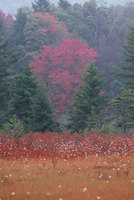 | Back to e-WV
| Back to e-WV
 The West Virginia Encyclopedia
The West Virginia Encyclopedia
 | Back to e-WV
| Back to e-WV
 The West Virginia Encyclopedia
The West Virginia Encyclopedia

Bogs are wetlands with an accumulation of peat derived from incomplete decomposition of plant remains. Low available oxygen, due to saturated conditions, and high acidity contribute to the incomplete decomposition. Sphagnum moss and sedges form the bulk of the peat in the state. More northerly bogs, outside West Virginia, often form around lakes. Bogs in the central Appalachians apparently have formed in depressions and as a result of stream levee formation. Behind these levees wet conditions persist, making ideal locations for sedges and sphagnum moss to thrive and for the deposition of peat. Cranberry Glades is an excellent example of this type of formation.
Bogs can form relatively quickly, as was documented by radiocarbon dating of peat in a shallow bog in the Canaan Valley area. This peat accumulation occurred in less than 50 years. Some bogs, such as Cranberry Glades, have more than 10 feet of peat, the result of 10,000 years of deposition. Pollen that has been preserved in West Virginia provides important clues to ancient times. Because of the slow and incomplete decomposition of peat and the protective coating of pollen grains, pollen may survive in these systems for thousands of years. Bogs in the central Appalachians have had cores removed and pollen from various depths analyzed. Analysis of pollen grains has revealed that West Virginia’s climate has become wetter and warmer during the last 10,000 years, thus bogs act as ‘‘libraries’’ of historical climatic and vegetational change.
Many plants other than sedges and mosses occur in bogs, including grasses, bog goldenrod, cranberries, several showy orchids, blueberries, chokeberries, and unique insectivorous species such as pitcher plants and sundew. Most bogs in the state are restricted to higher elevations where there is ample precipitation and a cool climate. Good examples are Cranberry Glades, Pocahontas County; Cranesville Swamp, Preston County; and Alder Run Bog and Big Run Bog, Tucker County. In addition, there are numerous bogs in Canaan Valley.
Written by Brian McDonald
Darlington, H. C. Vegetation and Substrate of Cranberry Glades, West Virginia. Botanical Gazette, (1943).
Watts, W. A. Late Quaternary Vegetation of Central Appalachia and the New Jersey Coastal Plain. Ecological Monographs, (1979).